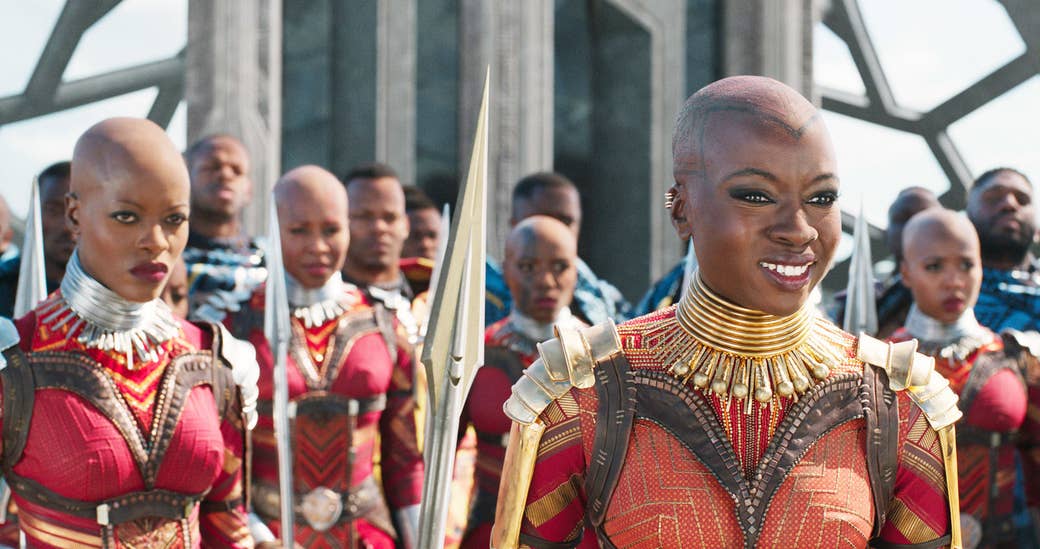
There’s a scene toward the end of Ryan Coogler’s record-smashing hit Black Panther in which Killmonger (Michael B. Jordan) cuts a woman’s throat. The woman is a member of the Dora Milaje, an all-female special forces unit tasked with protecting the African utopia of Wakanda and its royal family. In a moment that’s blink-and-you’ll-miss-it quick, Killmonger uses the woman’s body as a shield, while the other Dora Milaje surround them. The woman only has time to say “Wakanda forever” before he kills her and her body hits the ground.
It’s rare to see Okoye (Danai Gurira) — the general of the Dora Milaje and Wakanda’s fiercest warrior — falter in battle, but for just a second, her face crumples in anguish. Then her despair quickly transforms into rage, and she lunges at Killmonger with renewed ferociousness, brandishing her spear.
Though Okoye is romantically involved with W'Kabi (Daniel Kaluuya), and the strength of their relationship saves Wakanda from a bloody civil war, there’s still something about the way Okoye mourns the death of the woman that suggests she might have meant more to her than just a fellow fighter or friend.
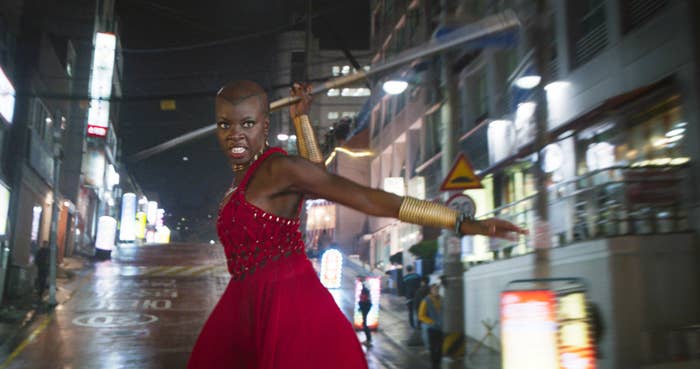
Or maybe I’m just reading way too much into this scene just because it reminded me so strongly of other moments from two other major superhero blockbusters over the past year. In Taika Waititi’s Thor: Ragnarok from last fall, a flashback of a battle between Tessa Thompson’s Valkyrie and the movie’s villain Hela (Cate Blanchett) ends with Valkyrie reaching desperately for one of her fellow female Asgardian warriors, who’s just been killed; there’s a look of agony on Valkyrie’s face. And in last summer’s Wonder Woman, directed by Patty Jenkins, when Robin Wright’s Antiope dies early in the movie’s first act — killed by a bullet shot by German soldiers who’ve invaded the mythical all-women island of Themyscira — her right-hand woman, Menalippe (Lisa Loven Kongsli) screams and runs to her side, crying into the sand.
All three movies have been not only celebrated contributions to the renaissance of the superhero film, but also praised for featuring more women and people of color both in front of and behind the cameras than many of their predecessors. They also all invoke the mythology of exclusively women warrior tribes — tribes that, according to the comics from which the movies were adapted, featured a number of queer characters. But you probably wouldn’t know that based on the movies alone — not unless you know where to look. Strong warriors mourning the deaths of their fellow female soldiers, who sure seem like they might have been more than friends, is the kind of subtle queer coding that LGBT viewers have come to expect (a lot of the lesbian and bisexual characters in film and TV these days wind up dead).
Getting queer characters into a movie isn’t as simple a matter as casting. As the critic Mark Harris wrote for Film Comment in an essay about stalled LGBT representation in today’s American cinema, a character isn’t queer unless “a writer figures out a way to make it known.” Mourning a lover can be one of those ways, subtle enough not to rankle the international markets, but significant enough that queer viewers might take the bait. The ever-popular dead-lover trope, whether intentional or not, is one of the laziest sorts of queerbaiting, and beyond its obvious offensiveness — why are so many lesbian or bisexual characters still relatively anonymous, killed, or both in 2018? — at this point it’s mostly just plain boring. Even the more pleasant little maybe-queer moments we’re starting to see in some blockbusters lately (a touch or a glance, a flirty line) amount to pretty lame attempts at LGBT inclusion, which Hollywood is getting outsize credit for. When will we stop seeing the same tired tropes recycled over and over again?
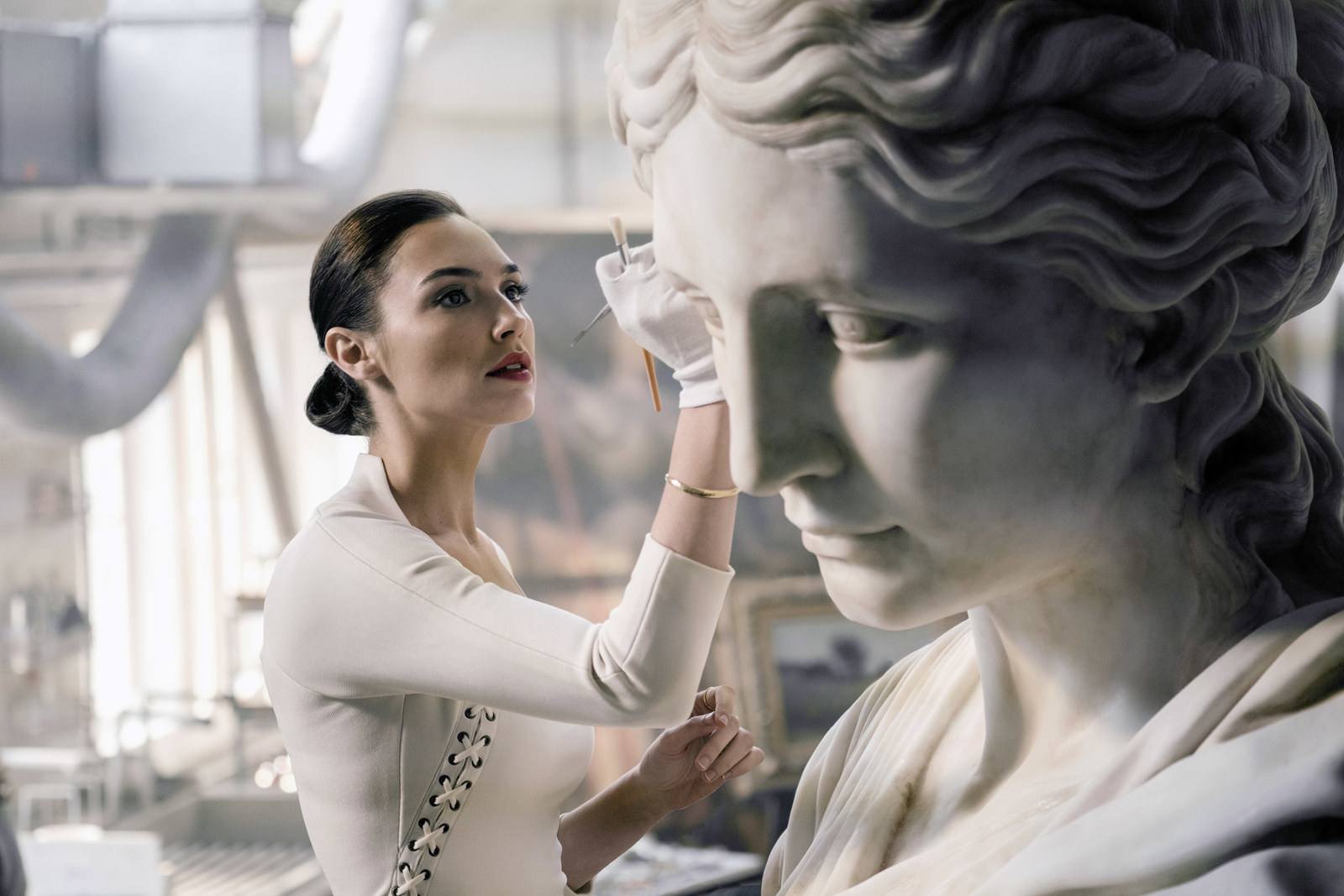
The assumption that all the Amazons in antiquity were lesbians is mostly a modern invention, but Wonder Woman’s origin story still has super queer roots. William Marston, the creator of the Wonder Woman comics, based Amazons and their Paradise Island not only on those from Greek mythology, but also on the two women with whom he shared his life: his wife, Elizabeth Marston, and their romantic partner Olive Byrne. Olive and Elizabeth raised their children together and remained partnered after William’s death. In 2016, DC Comics writer Greg Rucka confirmed that Wonder Woman herself is also bisexual, as fans of the comics had long suspected (the girl grew up on an island of all women — I mean, come on).
In October, Variety asked Wonder Woman star Gal Gadot about Rucka’s comments, and whether or not Wonder Woman is bisexual in the film. “It’s not something we’ve explored,” she said. “It never came to the table, but when you talk theoretically about all the women on Themyscira and how many years she was there, then what he said makes sense. In this movie she does not experience any bisexual relationships. But it’s not about that. She’s a woman who loves people for who they are. She can be bisexual. She loves people for their hearts.”

Gadot’s Diana makes one joke about “the pleasures of the flesh” during a conversation with Steve that leads one to believe she might have had experiences with women — “men are essential for procreation but when it comes to pleasure, unnecessary” — though she just as easily could be talking about, y’know, masturbation. It’s likelier that, as Gadot says, Diana’s bisexuality “never came to the table.”
But the first installment of her new franchise could have been so much queerer — that is, queerer in terms of gender and power; queerer as in, less invested in heteropatriarchy and the havoc it wreaks — without having to make Diana herself explicitly queer at all. If only the spirit of Themyscira wasn’t extinguished the moment Diana left her home island’s shores. She never seems to reflect back on her childhood, or mine her memories for the things her aunts taught her. (Both Antiope and Menalippe are Diana’s aunts, and, at least according to Greek mythology, sisters, but...whatever.) Antiope’s death might have seemed less cheap if we at least got the sense from Diana that her life mattered.
But at the very least, all the queer Wonder Woman subtext was made textual in a SNL skit last October, with Kate McKinnon playing a lesbian human who’s just washed ashore on Themyscira and is surprised to learn none of the Amazons identify as lesbians. “The whole thing seems so super gay!” she says, baffled. Diana, in full Wonder Woman gear, gives her a kiss out of pity, though afterwards she says, “I feel nothing.” If Wonder Woman doesn’t feel even a little bit queer while making out with Kate McKinnon, perhaps there’s no hope for her after all.
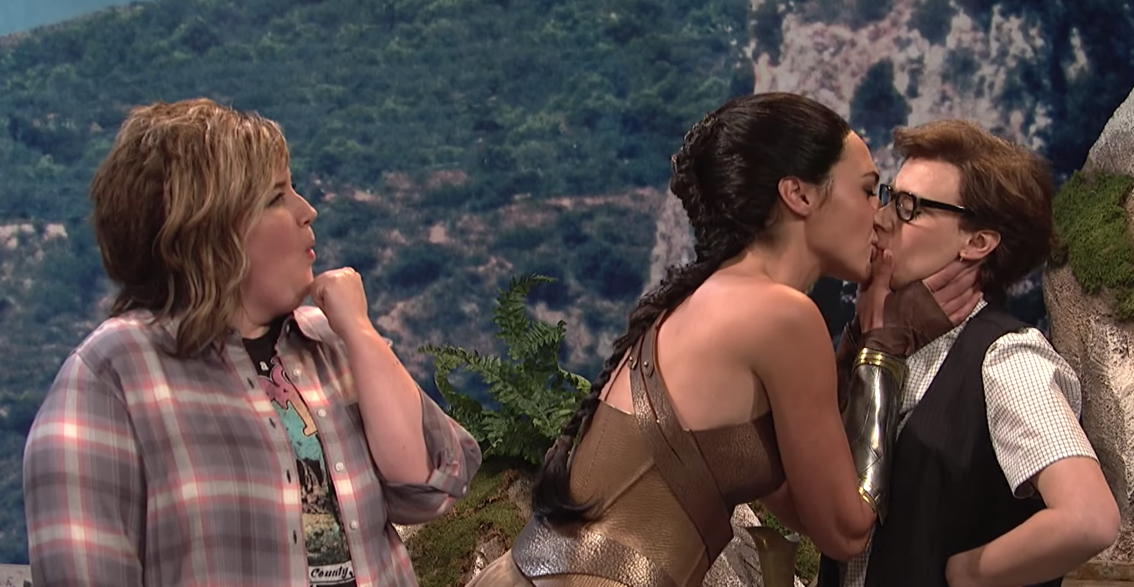
In Thor: Ragnarok, we get a better sense of how fighting with an all-women army, and watching that army fall, has influenced Thompson’s Valkyrie. Thor (Chris Hemsworth) crash-lands on a planet overflowing with garbage where Valkyrie’s been hiding out and working as a bounty hunter, drinking away her memories of life on Asgard. She captures Thor and sells him to the Grandmaster (Jeff Goldblum), and it’s only later when Thor forces her to remember how Hela ruined her life that she agrees to help him battle her. After all, Hela killed the woman she loved.
That’s how Thompson played the character, anyway, according to an October Rolling Stone profile: "There's a great shot of me falling back from one of my sisters who's just been slain,” she says. “In my mind, that was my lover."
Valkyrie is bisexual in the Marvel comics upon which the Thor movies are based — openly so, and in a relationship with the anthropologist Annabelle Riggs. Thompson tried to convince director Taika Waititi that her character should be explicitly bi in the movie, and according to Rolling Stone, he agreed to shoot a glimpse of a woman walking out of Valkyrie’s bedroom, though eventually it had to get cut for time. Thompson wrote on Twitter earlier in October that when she played Valkyrie she was “faithful” to the original character’s bisexuality “in her depiction” even though “her sexuality isn’t explicitly addressed.”
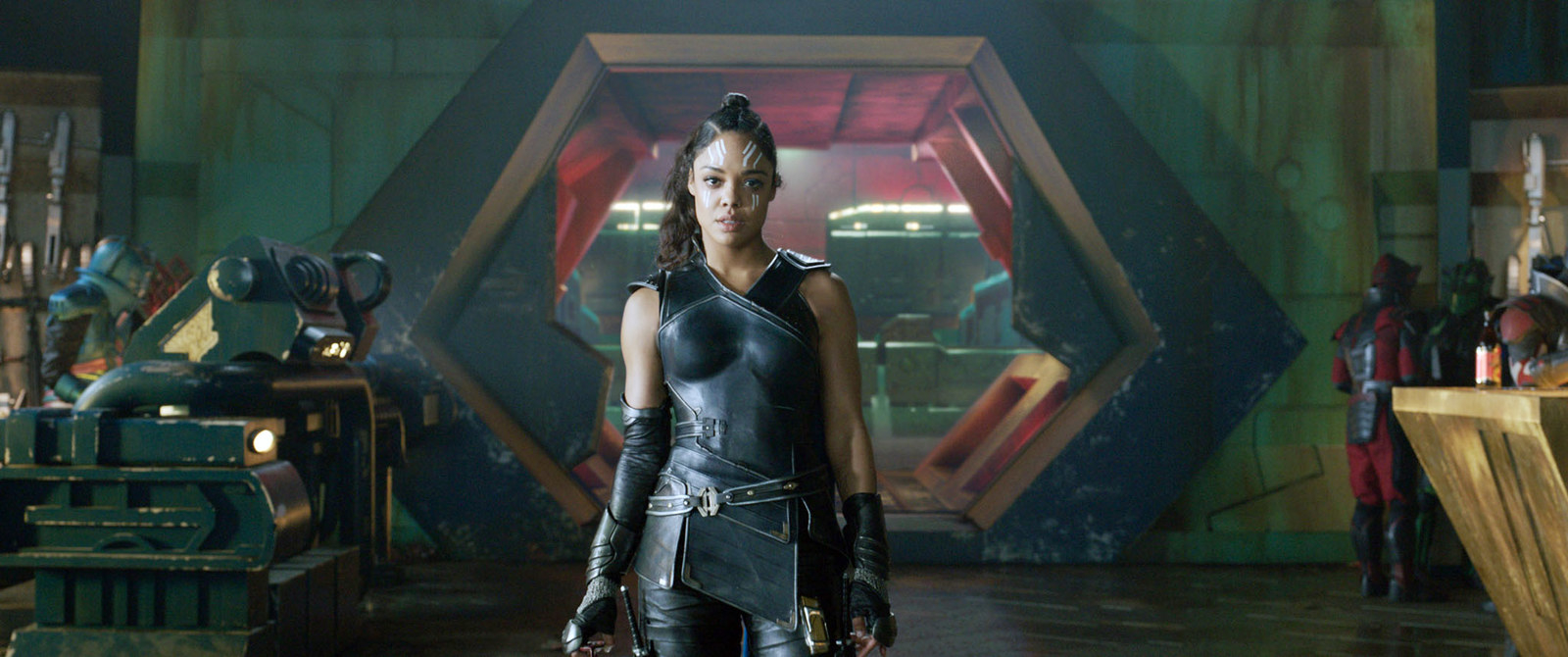
We don’t end up missing much; a woman walking out of a room is barely more confirmation of Valkyrie's bisexuality than the existing scene where she watches her lover die. Thor: Ragnarok’s queerest vibes instead come from other characters: Blanchett’s Hela is a delightfully evil drag queen villain in the vein of the Ursulas and Maleficents who came before her, while Goldblum’s Grandmaster is another flamboyant bad guy in eyeliner you can’t help but (kind of) root for. A queer king of a garbage island making a pretty blonde boy do his bidding? You’ve gotta admit it’s fun, even though, yeah, #problematic.
It’s a bummer that there’s a good amount of (evil) queer joy in Thor: Ragnarok, but the one heroic character who’s supposed to be canonically queer gets stuck only with queer loss and pain. But better to be queerly devastated than queerly dead, I suppose.
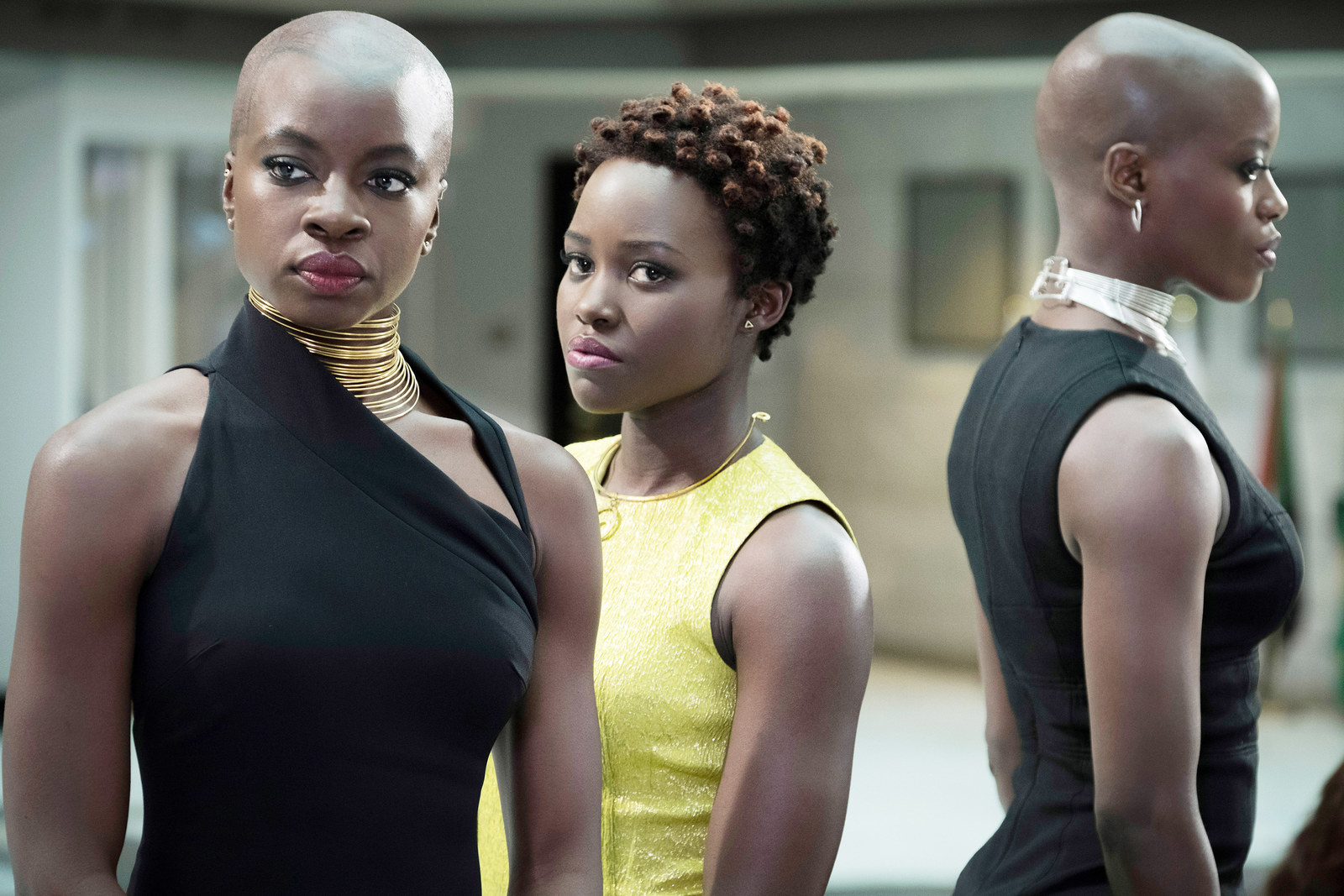
For all of the boundaries Black Panther’s broken down, from its refusal to plod along the usual, ideologically vacuous good versus evil plotlines, to its Afrofuturistic costuming and set designs, to its history-making, record-breaking success, its reception has still been tinged, in certain circles, by a bit of disappointment.
In a spinoff of Ta-Nehisi Coates’ Black Panther, Roxane Gay and Yona Harvey’s Black Panther: World of Wakanda, a love story unfolds between two members of the Dora Milaje, Ayo and Aneka. One of those women, Ayo, is portrayed in Coogler’s Black Panther by Florence Kasumba, but she doesn’t have any romantic relationships in the movie. Last April, Vanity Fair reported that an earlier cut of the film featured a scene in which Danai Gurira’s Okoye and Ayo make eyes at each other. “You look good,” Okoye says, and Ayo responds in kind. “I know,” Okoye says, grinning.
After the story was published, a Marvel representative reached out to Vanity Fair to say that “the nature of the relationship between Danai Gurira’s Okoye and Florence Kasumba‘s Ayo in Black Panther is not a romantic one and that specific love storyline from the comic World of Wakanda was not used as a source.”
But rumors about that scene surfaced again earlier this month, when E. Oliver Whitney at Screencrush asked screenwriter Joe Robert Cole about the deleted scene, and whether it was supposed to imply a queer romance between Okoye and Ayo. “I think the short answer is yes,” he said, pointing out that the filmmakers had played around with a few different storylines and character arcs, though he doesn’t remember that deleted scene in particular.
In mid-February, Gay told the Advocate that the deletion of that scene was disappointing. “Even when great progress is made, some marginalized groups are told to wait, are told, not yet, are told, let's do this first and then we will get to you," she said. "And we are also told we're asking too much, that we should be grateful for what progress is being made. But I don't buy into that. It would have been incredible and so gratifying to see a queer black woman in what will likely be the biggest movie of the year. Alas, not yet."
Even if that scene between Okoye and Ayo had been included in the final cut of the movie, it wouldn’t have been much more an explicit queer romance than a shot of a woman leaving Valkyrie's room in Thor: Ragnarok, or Okoye mourning a fellow soldier’s death. Do we even need these tiny little moments of queer confirmation, when they might not even be noticeable to anyone in the audience who isn’t trained to look out for signals that possibly, perhaps, just maybe something queer could be going on here? They’re crumbs when LGBT audiences deserve a feast.
Black Panther missed an opportunity to include the stories of explicitly queer black women at a time when queer characters of color are still grossly underrepresented in mainstream media. But that doesn’t mean the movie fails to leave any room for queerness. Les Fabian Brathwaite, writing for Out magazine, argues that even without the deleted scene, Black Panther still feels “inclusive and representative of queer identity.” For one thing, the Dora Milaje channel both masculinity and femininity with their bald heads and bold lips. At one point, Okoye “literally snatches her own wig during one of the film’s most thrilling battles.” She throws her wig in some white guy’s face! The scene functions as both a fuck-you to white, Western beauty standards and an incredible addition to the queer canon of wig-snatching — the GIF is already iconic.
Plus, Brathwaite writes, Black Panther “imagines an African nation that was never conquered, never colonized, and is therefore free from the scars of that defilement.” We can therefore assume that Wakanda would function similarly to precolonial African societies, in which “ideas about gender and sexuality were shaped by tradition but ran contrary to what Christian colonists believed acceptable or natural.” Many of the anti-gay laws in African countries today can be traced back to the imports of imperialism; we can guess that Wakanda, left to develop its own value systems, would be a place where queer people are not only tolerated, but celebrated.
Still, it’s one thing to imagine a world’s possibilities and another to see those possibilities come to fruition. Speaking to Vulture, Florence Kasumba said earlier this month that she’d “love to” see her character Ayo’s sexuality explored in the future of the MCU “at some point. Not now, because it’s too soon. At this point, the focus is somewhere else.”
“Some point” might not be too far away. They're not on the big screen, but the queer plotlines on the CWs' Supergirl and, more recently, Black Lightning have excited LGBT superhero fans; in the latter, Nafessa Williams plays Anissa Pierce, who fights crime as Thunder, a groundbreaking black lesbian superhero. And Thompson just told Cinemablend that in Marvel’s upcoming fourth phase, “Women reign supreme.” Maybe someday soon queer characters will too. ●
